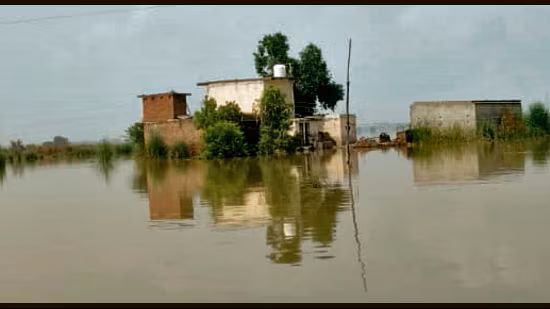 The 2025 floods have unleashed devastation across Punjab on both sides of the border—India and Pakistan—bringing villages, towns, and farmlands under water. Rivers like the Sutlej, Ravi, and Chenab have swollen beyond their banks, submerging entire settlements. In Pakistan’s Punjab, nearly 1.2 million people have been affected, with more than a million evacuated from low-lying areas. In India’s Punjab, thousands of acres of farmland, along with homes and even some historic religious sites, are reeling under the rising waters. Families have been displaced in large numbers, forced to take shelter in makeshift camps, schools, and gurdwaras.
The 2025 floods have unleashed devastation across Punjab on both sides of the border—India and Pakistan—bringing villages, towns, and farmlands under water. Rivers like the Sutlej, Ravi, and Chenab have swollen beyond their banks, submerging entire settlements. In Pakistan’s Punjab, nearly 1.2 million people have been affected, with more than a million evacuated from low-lying areas. In India’s Punjab, thousands of acres of farmland, along with homes and even some historic religious sites, are reeling under the rising waters. Families have been displaced in large numbers, forced to take shelter in makeshift camps, schools, and gurdwaras.
Governments in both Punjabs have launched rescue and relief efforts. In Pakistan, the provincial administration has described the operation as the largest in nearly four decades, deploying the army, PDMA, and Rescue 1122 to evacuate villages and supply essentials. Financial aid worth billions of rupees has been announced to support those who have lost homes, crops, and livestock. Relief camps equipped with food, medical aid, and veterinary services are being run across the flood-hit districts. Authorities have also promised long-term projects to improve drainage, strengthen embankments, and prevent future urban flooding.
On the Indian side, the Punjab government has focused on assessment and compensation. Chief Minister Bhagwant Mann has ordered a special survey (girdawari) to record the scale of damage, promising transparent compensation for farmers and households. Emergency supplies of food, medicines, and temporary shelter have been rushed to affected districts like Sangrur, Patiala, and Jalandhar. The Indian Army has deployed modern amphibious vehicles to rescue people stranded in deep waters, especially in regions where traditional rescue boats cannot reach. Preventive steps such as floodwater storage ponds and anti-encroachment drives have also been highlighted by local officials.
Yet, despite all these measures, a large section of flood victims remains angry and dissatisfied with the government’s response. Many displaced families complain that relief material is not reaching them, and when it does, it is inadequate. Villagers allege that aid distribution is influenced by political connections, leaving ordinary people helpless. Farmers, who have seen their standing crops destroyed, argue that the promised compensation is too little and too late. Several opposition parties have accused the government of making tall claims while failing to deliver on the ground, pointing out that crores of rupees previously allotted for flood-prevention projects have not been accounted for. In many areas, victims openly admit that it is only the social workers, youth volunteers, and religious charities who are keeping them afloat—literally and figuratively.
The floods have once again highlighted the crucial role of NGOs, gurdwaras, and community-based organizations. In Pakistan, groups like the Alkhidmat Foundation have been distributing rations, medicines, and clean water to displaced families. In Indian Punjab, organizations such as KhalsaAid, Aasra International, and farmer unions have stepped in with food packets, tarpaulins, medical teams, and even diesel for water pumps. Many gurdwaras have opened their doors to shelter flood-hit people, continuing the tradition of seva (selfless service). Volunteers have risked their lives, wading through waist-deep waters to deliver help where official agencies have been slow or absent.
The political debate is growing sharper, with opposition leaders demanding higher compensation, a transparent audit of funds, and long-term infrastructure investment to prevent such tragedies from repeating. But beyond politics, what stands out is the resilience of ordinary Punjabis. Farmers helping farmers, youth ferrying relief on tractors, and faith-based groups providing shelter reflect a community spirit that rises when governments fall short.
Ultimately, the 2025 floods are not only a test of nature’s fury but also a test of governance. They serve as a reminder that while announcements and figures make headlines, people on the ground judge governments by how quickly and fairly relief reaches them. In Punjab today, that judgment is harsh—most victims feel abandoned, and it is the people’s solidarity, not the state’s machinery, that is keeping hope alive.